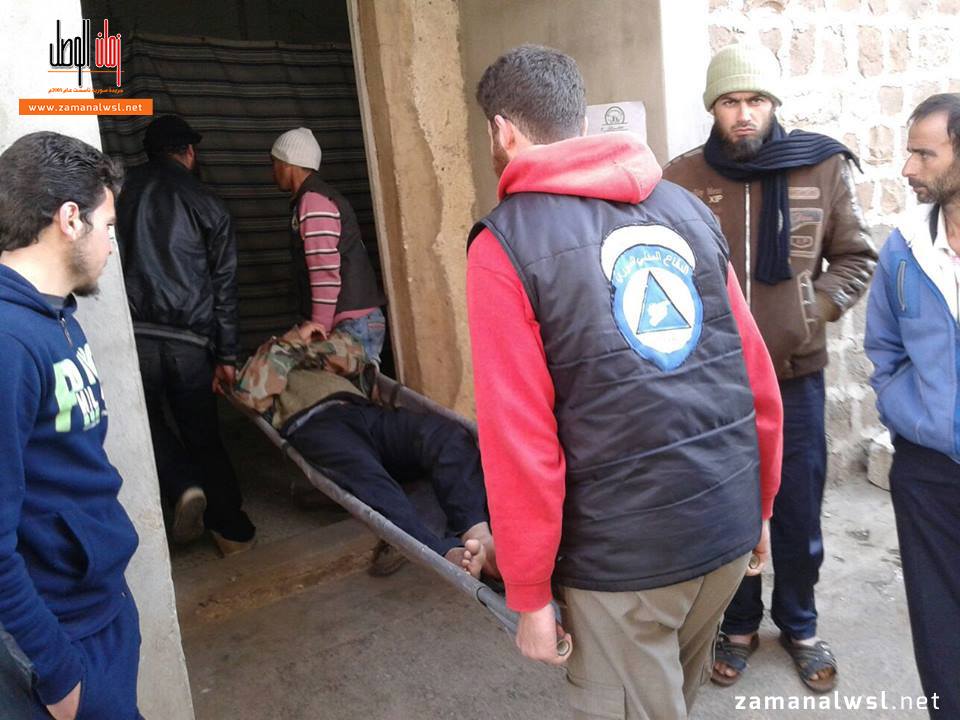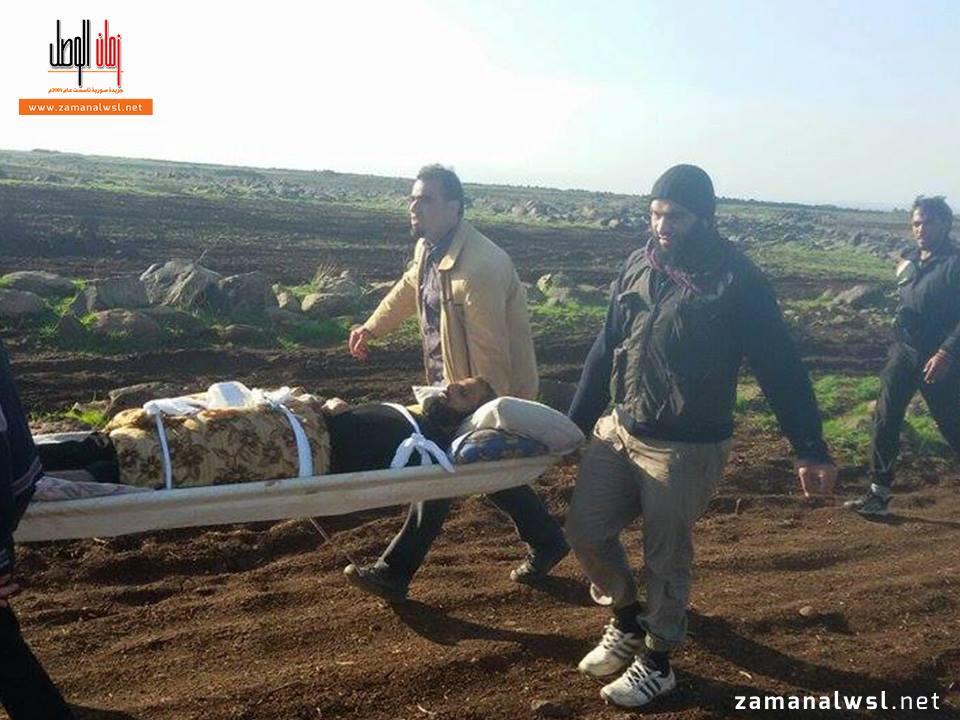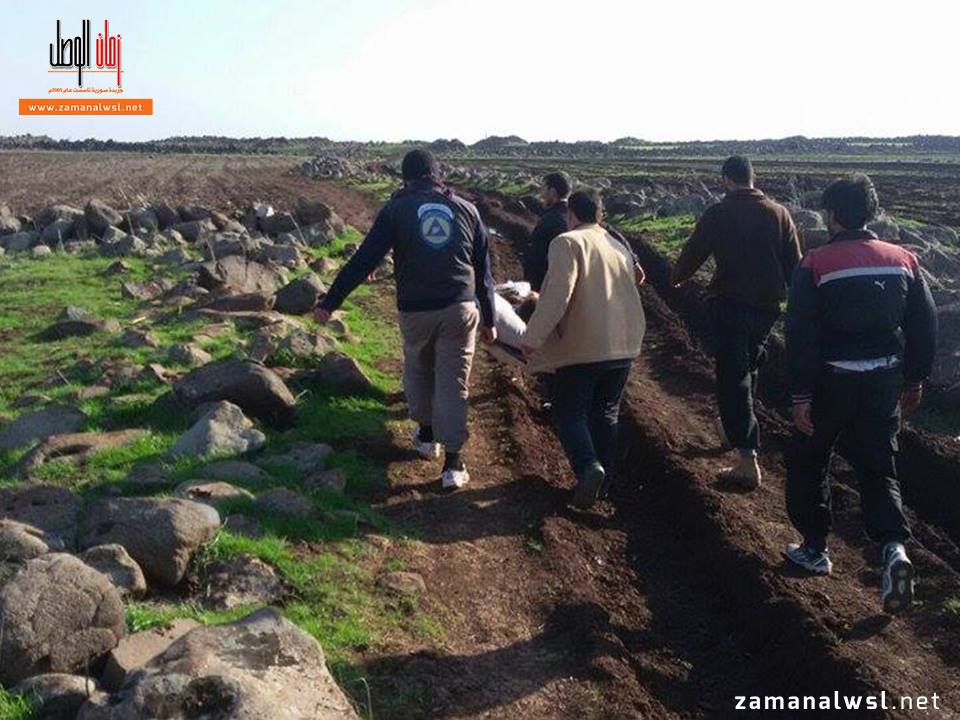Translation by Yusra Ahmed
(Zaman Al Wasl)- Recent Syrian regime’s military campaign and Russian airstrikes on the countryside of Hama have increase the burden on the civil defense forces, which already suffer of shortage of manpower and equipment.
Zaman Al Wasl has observed the suffering of the “white helmets” in Harbanafsa town in Southern Countryside of Hama and difficulties they face during evacuating wounded and victims, as well as transferring them to hospitals or medical stations.
The suffering of civil defense has been exaggerated with the Russian airstrike for almost 40 days on the countryside of Hama, as they needed to carry victims on shoulders and transfer them on foot for more than 7 miles (10 km) of rough rugged roads , risking their lives when they cross open roads between villages of Jadrin and Kafrnan, where regime’s barriers and snipers situated, Mohammed, a volunteer said.
“things get much worse with rain, as roads become difficult to use even on foot”, Mohammed Added.

Abo Bilal, the Head of Civil Defense sector on Hola town, described their suffering when transferring the wounded from Harbanafasa as “unbearable” and “outreaches the endurance of human being”.
Abo Bilal explained that the equipment of the sector are acceptable, but still they suffer of lack of heavy and middle size equipment as well as manpower, beside safety equipment of workers like helmets.
“we have been provided with an ambulance and some equipment last year from the support we have prior to establishing the sector, but still suffer of lack of fuel and high prices besides specialized equipment”, Abo Bilal added.

Holeh city and surrounding villages, of 75 Thousand people, in the Northwest countryside of Homs, is considered the second biggest opposition gathering after Homs city, and it is very much in need for more civil defense forces and equipment.
The civil defense or “White Helmet” in Syria were established in 2013 and now they count more than 2700 members. The idea started when the Syrian regime started bombing areas that were described as liberated after the regime withdrawal from them by the end of 2012, which gave it the excuse to bomb civilian community.
The “motto” of civil defense is a verse from the Quran: "To save one life is to save all of humanity", and that the reason push the civil defense to respond to bombs or go into areas that contained soldiers from the Assad regime, even sometimes they rescued Iranian fighters that have been fighting on behalf of the regime and members of Hezbollah.

The civil defence in North countryside of Homs has started working as small groups of rescue volunteers two years ago. In 2014, a directorate has been established in Rastan city and many sectors were formed in Rastan, Talbeseh and Holeh, besides sector in Alwaer neighbourhood in Homs city.
The Russian air strikes in Syria started in the beginning of October, 2015, claiming to target the Islamic State stronghold in A-Raqqa and Al-Qaeda's Syrian affiliate Al-Nusra Front, but concerns were built up when the strikes attacked rebel groups opposed to Syrian regime, in an attempt to support their long-term ally Bashar al-Assad and help him to stay.
Since the beginning, the US-led coalition urged Russia to stop attacking Syrian opposition forces, warning that it risked escalating the five-year war that has killed up to 270,000 people.
(Zaman Al Wasl)- Recent Syrian regime’s military campaign and Russian airstrikes on the countryside of Hama have increase the burden on the civil defense forces, which already suffer of shortage of manpower and equipment.
Zaman Al Wasl has observed the suffering of the “white helmets” in Harbanafsa town in Southern Countryside of Hama and difficulties they face during evacuating wounded and victims, as well as transferring them to hospitals or medical stations.
The suffering of civil defense has been exaggerated with the Russian airstrike for almost 40 days on the countryside of Hama, as they needed to carry victims on shoulders and transfer them on foot for more than 7 miles (10 km) of rough rugged roads , risking their lives when they cross open roads between villages of Jadrin and Kafrnan, where regime’s barriers and snipers situated, Mohammed, a volunteer said.
“things get much worse with rain, as roads become difficult to use even on foot”, Mohammed Added.

Abo Bilal, the Head of Civil Defense sector on Hola town, described their suffering when transferring the wounded from Harbanafasa as “unbearable” and “outreaches the endurance of human being”.
Abo Bilal explained that the equipment of the sector are acceptable, but still they suffer of lack of heavy and middle size equipment as well as manpower, beside safety equipment of workers like helmets.
“we have been provided with an ambulance and some equipment last year from the support we have prior to establishing the sector, but still suffer of lack of fuel and high prices besides specialized equipment”, Abo Bilal added.

Holeh city and surrounding villages, of 75 Thousand people, in the Northwest countryside of Homs, is considered the second biggest opposition gathering after Homs city, and it is very much in need for more civil defense forces and equipment.
The civil defense or “White Helmet” in Syria were established in 2013 and now they count more than 2700 members. The idea started when the Syrian regime started bombing areas that were described as liberated after the regime withdrawal from them by the end of 2012, which gave it the excuse to bomb civilian community.
The “motto” of civil defense is a verse from the Quran: "To save one life is to save all of humanity", and that the reason push the civil defense to respond to bombs or go into areas that contained soldiers from the Assad regime, even sometimes they rescued Iranian fighters that have been fighting on behalf of the regime and members of Hezbollah.

The civil defence in North countryside of Homs has started working as small groups of rescue volunteers two years ago. In 2014, a directorate has been established in Rastan city and many sectors were formed in Rastan, Talbeseh and Holeh, besides sector in Alwaer neighbourhood in Homs city.
The Russian air strikes in Syria started in the beginning of October, 2015, claiming to target the Islamic State stronghold in A-Raqqa and Al-Qaeda's Syrian affiliate Al-Nusra Front, but concerns were built up when the strikes attacked rebel groups opposed to Syrian regime, in an attempt to support their long-term ally Bashar al-Assad and help him to stay.
Since the beginning, the US-led coalition urged Russia to stop attacking Syrian opposition forces, warning that it risked escalating the five-year war that has killed up to 270,000 people.
















Comments About This Article
Please fill the fields below.